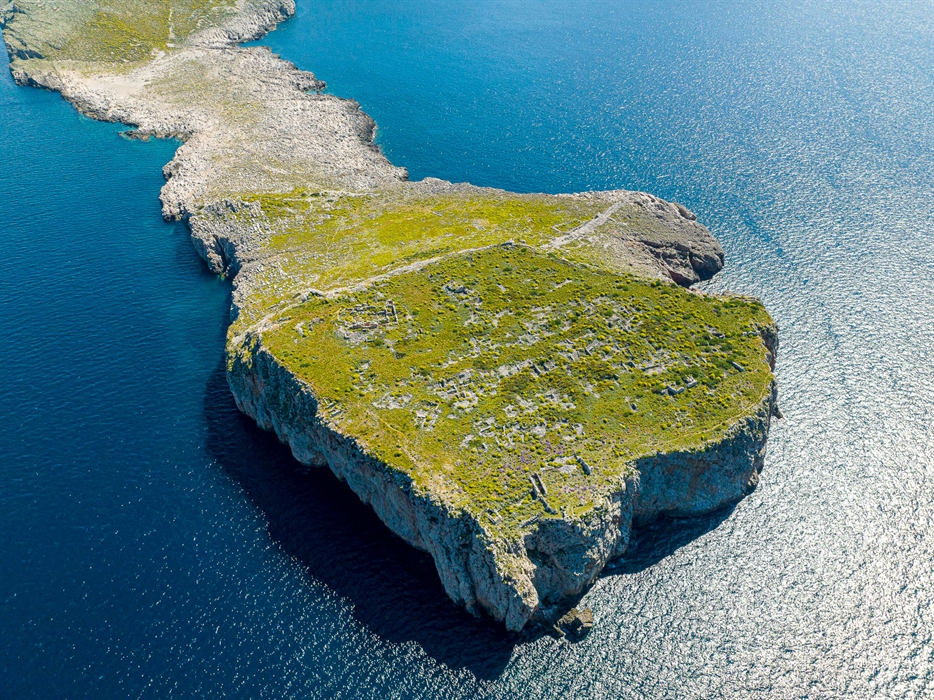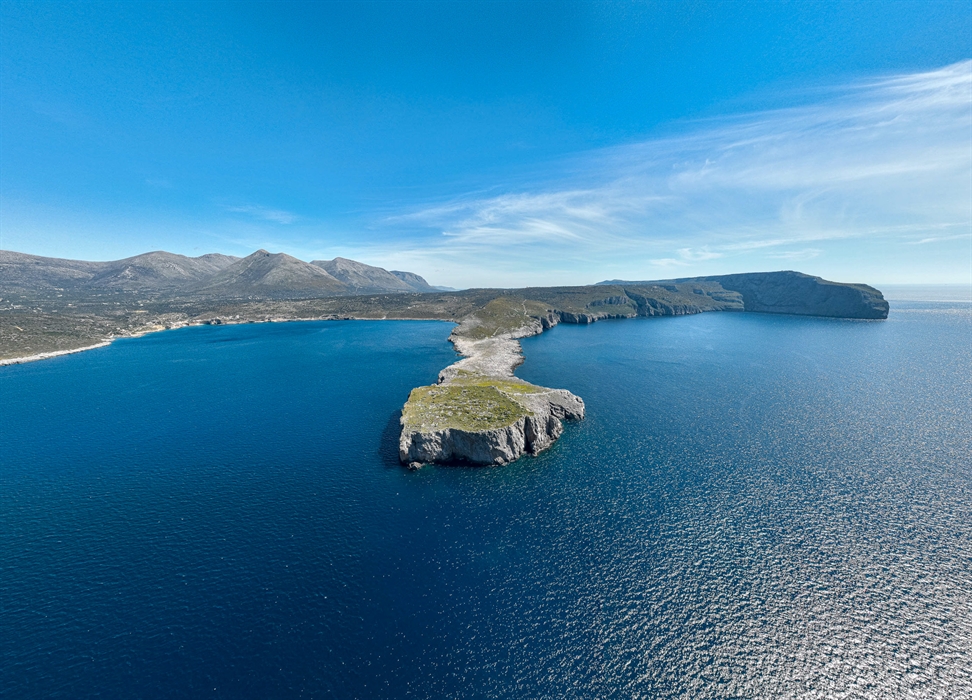Tigani Peninsula and Tigani Castle
Tigani means frying pan in Greek, and the peninsula at the bay of Mezapos in southwest Mani really does look like a frying pan if you see it from afar - and especially from above! You get to the ruins by walking along the “handle” of the frying pan, all in all a unique experience.
First of all, let's talk about the strange name for this 1700m rocky peninsula that juts out into the bay of Mezapos in southwest Mani. It is surrounded by the sea on three sides, and, yes, it does look like a frying pan if you see it from afar - and especially from above! Your walk to the ruins starts at Agia Kyriaki, and once you get to the "handle” you are in a unique, beautiful and slightly surreal landscape surrounded by the blue sea. There is no shade, and the wind can be strong and you’ll need decent shoes, but the views are amazing. Watch out for the pits in the limestone rocks, where the locals used to collect salt which must have been a hard task here, exposed to all the elements.
Once you get to the frying bit of the “pan”, things get even more interesting - especially if you let your imagination run free. You’ll find the remains of 3 public cisterns, a half-demolished medieval wall with a tower in the west, an ancient and relatively well preserved wall with Cyclopean masonry at its east end and Justinian elements at its west end. And then there are ruined towers and traces of Byzantine temples, including a large three-aisled basilica.
Now, as to what all this was, who built it and when – well there are varying opinions…
For some people, the cyclopean wall shows that the original fortification dates back to ancient times. The Byzantine buildings were added during the reign of Justinian (527-565) and the small state with its castle developed into an important military and administrative centre. The fortress had to defend itself from raids by Vandals, Crusaders, Arabs, Turks and was last used in 1570.
Other scholars believe that the castle in Tigani is actually the mysterious Grande Magne. We know that Grande Magne was built by William II Villeardouin in 1248 and was one of the great castles of the Peloponnese, along with Mystras and Monemvasia, but as yet we are not sure where it actually was. However, it is mentioned in the "Chronicle of the Morea", a 14th-century history text which tells how the Crusaders became established in the Peloponnese. This says that Grande Magne was built on a rock above a large natural harbour and that the whole area got its name from the castle. This is an interesting theory, but not at all certain - after all, there is no natural harbour below Tigani.
A little more is known about the large three-aisled basilica as it was excavated between 1964-1965 and 1977-1984. Archaeologists studied the masonry and found the apses, the sanctuary choir, parts of the pulpit and a large number of carvings from the iconostasis. Initially it was thought that the Basilica dated from the end of the 7th century, but after examining the masonry and the positioning of the statues, the archaeologists revised their theory and decided that the building dates from the second half of the 10th century or early 11th century. The magnificence and size of the church, as well as the fact that it was in a fortified settlement, led the archaeologists to think that the castle which protected the church and the other buildings might be the fabled Grande Magne. The church was used up until the Turkish occupation. The remains of a necropolis that was used in the late 5th - early 6th century was also found here.
Did you know that
There are other theories about where Grande Magne was, with Kelefa, Lefktro, and Zarnata Castles being possibilities.
Location
Find the destination on the interactive map below.
Categories
Weather
Σχετικό περιεχόμενο χρηστών (UGC)
Ενημερωθείτε για ενδιαφέροντα θέματα γύρω από τον προορισμό μέσα από το περιεχόμενο των χρηστών μας
Discover 7 hidden gems of the Peloponnese
Many of you may have already visited some of the most renowned attractions…
TOP 10 archaeological museums in the Peloponnese
Olympia, Mycenae, Epidaurus, Diros Cave, Ancient Corinth, Messene and…
TOP 10 Castles in the Peloponnese
Castles galore! Mystras, Monemvasia, Palamidi, Methoni, Koroni,…
Newsletters
- About us
- FAQ's
- Map
- Tourism information centers
- Disclaimer
- Sitemap
- Our brand
- Media roum
- Adding your bussiness
- Corporate
- MICE

Peloponnese. Greece beyond the obvious





Design and creation from Cosmote
Marinas and Moorings
Diving centers
Get inspired
- Media gallery
- Blog
- The Peloponnese in the media
- Your feedback
- Users' general content
- Users' local products
- Users' events content
- Ask a local
More
- Accommodation
- Travel agencies
- Restaurants
- Services
- Destinations Map
- Weather
- Public transport
- Events
- Frequently asked questions
- Useful phones
- B2B
- Destination Data
- Contact


